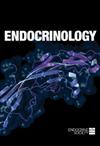The deletion of nuclear progesterone receptors from kisspeptin cells does not impair negative feedback in female mice.
IF 3.8
3区 医学
Q2 ENDOCRINOLOGY & METABOLISM
引用次数: 0
Abstract
Reproductive function in mammals depends on the ability of progesterone to suppress pulsatile gonadotrophin-releasing hormone (GnRH) and luteinizing hormone (LH) secretion in a homeostatic negative feedback loop. Previous research identified that cells upstream from GnRH neurons expressing the nuclear progesterone receptor (PGR) are required for progesterone-negative feedback. However, the identity of these cells and the mechanism by which they reduce GnRH/LH pulsatile secretion is unknown. We aimed to address the hypothesis that PGR expressed by a neural population in the arcuate nucleus recently identified as the GnRH pulse generator, cells expressing Kisspeptin, Neurokinin B, and Dynorphin (KNDy cells), mediate progesterone negative feedback. To achieve this, we utilized female mice with the PGR gene conditionally deleted from kisspeptin cells (KPRKO mice) and observed a substantial decrease in the percentage of KNDy neurons co-expressing PGR mRNA (11% in KPRKO mice versus 86% in wildtype mice). However, KPRKO mice did not display changes in the frequency or amplitude of LH pulses in diestrus or estrus, nor in the ability of exogenous progesterone to blunt a post-castration rise in LH. Further, mRNA expression of arcuate kisspeptin and dynorphin, which are excitatory and inhibitory to GnRH secretion, respectively, remained unaltered in KPRKO mice compared to wildtype controls. Together, these findings show that the near-complete loss of PGR signaling from KNDy cells does not impact negative feedback regulation of GnRH pulse generation in mice, suggesting that feedback through this receptor can occur via a small number of KNDy cells or a yet unidentified cell population.从kisspeptin细胞中删除核孕酮受体不会损害雌性小鼠的负反馈。
哺乳动物的生殖功能取决于孕酮在一个平衡负反馈回路中抑制促性腺激素释放激素(GnRH)和黄体生成素(LH)分泌的能力。以前的研究发现,GnRH 神经元上游表达核孕酮受体(PGR)的细胞是孕酮负反馈所必需的。然而,这些细胞的身份及其减少 GnRH/LH 脉动分泌的机制尚不清楚。我们的目的是解决这样一个假设,即最近被确认为 GnRH 脉冲发生器的弓状核中的神经群(表达 Kisspeptin、Neurokinin B 和 Dynorphin 的细胞(KNDy 细胞))所表达的 PGR 介导了孕酮负反馈。为了实现这一目标,我们利用从kisspeptin细胞中有条件地删除了PGR基因的雌性小鼠(KPRKO小鼠),观察到共同表达PGR mRNA的KNDy神经元的百分比大幅下降(KPRKO小鼠为11%,而野生型小鼠为86%)。然而,KPRKO 小鼠在发情期或绝经期的 LH 脉冲频率或幅度没有发生变化,外源性黄体酮抑制绝经后 LH 上升的能力也没有发生变化。此外,与野生型对照组相比,KPRKO 小鼠中分别对 GnRH 分泌具有兴奋和抑制作用的弧吻肽(kisspeptin)和达因啡(dynorphin)的 mRNA 表达没有变化。这些发现共同表明,KNDy 细胞中 PGR 信号的几乎完全丧失并不影响小鼠 GnRH 脉冲产生的负反馈调节,这表明通过该受体的反馈可通过少量 KNDy 细胞或尚未确定的细胞群发生。
本文章由计算机程序翻译,如有差异,请以英文原文为准。
求助全文
约1分钟内获得全文
求助全文
来源期刊

Endocrinology
医学-内分泌学与代谢
CiteScore
8.10
自引率
4.20%
发文量
195
审稿时长
2-3 weeks
期刊介绍:
The mission of Endocrinology is to be the authoritative source of emerging hormone science and to disseminate that new knowledge to scientists, clinicians, and the public in a way that will enable "hormone science to health." Endocrinology welcomes the submission of original research investigating endocrine systems and diseases at all levels of biological organization, incorporating molecular mechanistic studies, such as hormone-receptor interactions, in all areas of endocrinology, as well as cross-disciplinary and integrative studies. The editors of Endocrinology encourage the submission of research in emerging areas not traditionally recognized as endocrinology or metabolism in addition to the following traditionally recognized fields: Adrenal; Bone Health and Osteoporosis; Cardiovascular Endocrinology; Diabetes; Endocrine-Disrupting Chemicals; Endocrine Neoplasia and Cancer; Growth; Neuroendocrinology; Nuclear Receptors and Their Ligands; Obesity; Reproductive Endocrinology; Signaling Pathways; and Thyroid.
 求助内容:
求助内容: 应助结果提醒方式:
应助结果提醒方式:


